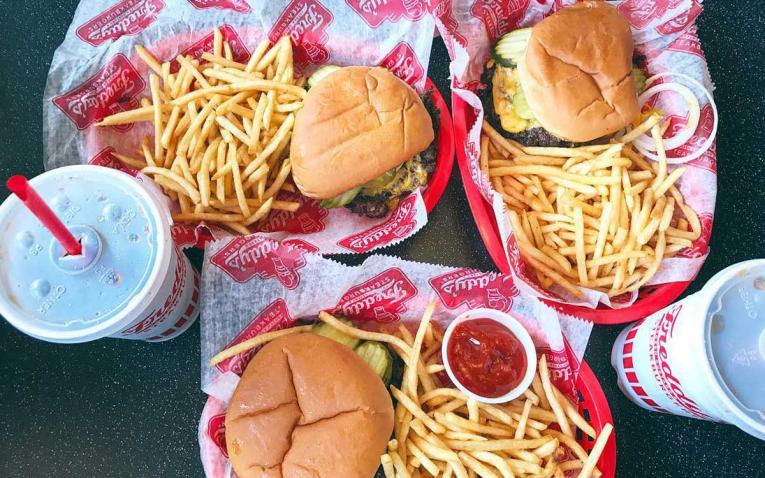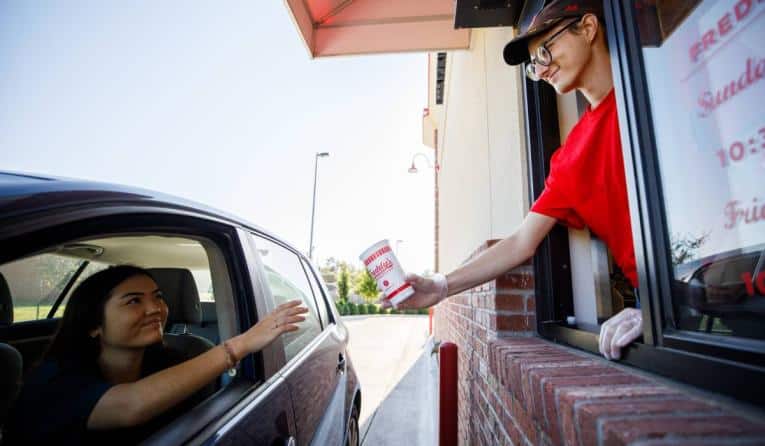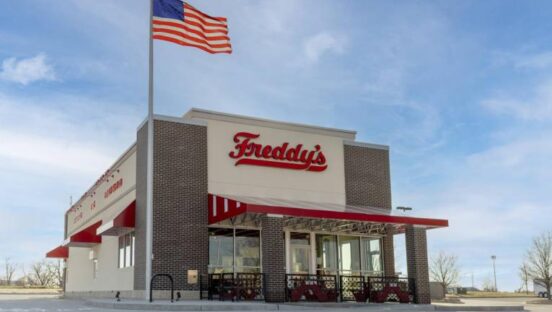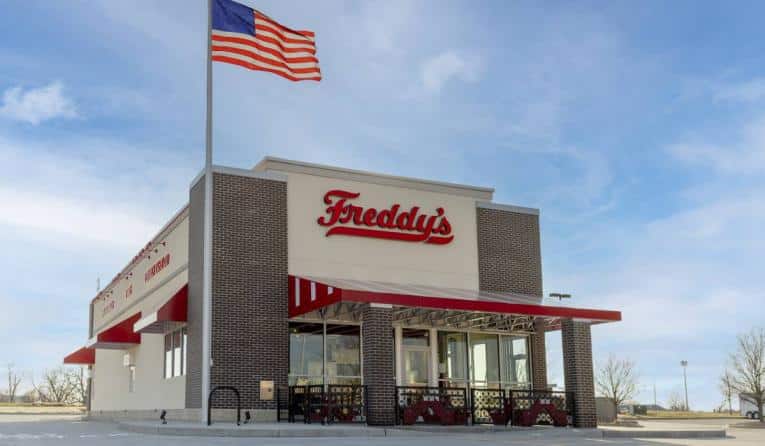Freddy’s Frozen Custard & Steakburgers has added more than 100 commitments to its growth pipeline this year already. That after just shy of 130 last year and 117 the calendar before. As one of QSR’s Franchise Council members phrased it recently, “this quiet success story from the Midwest” has left its low profile behind. But how and why the burger brand charted rapid growth during an era of delays, surging inflation, and the continued recovery of the sector out of COVID, trails back to the origin, says Chris Dull, CEO and president, who took over the top post in May 2021.
Freddy’s was founded in 2002 by brothers Bill and Randy Simon along with their friend and business partner, Scott Redler. They were all deep into franchising. Yet Freddy’s wasn’t incepted with that vision of growth. It was first designed to honor Bill and Randy’s dad, Freddy Simon, a U.S. Army vet who served in the Pacific Rim during World War II. Freddy earned the Purple Heart and a Bronze Star for valor. When he returned to Kansas, he went on to raise six children and clock 56 years in the hospitality sector.
While Freddy’s didn’t initially eye franchising, the opportunity materialized shortly. And when it did, Dull says, you had a trio of franchisee-first minded leaders devising a model to scale. It’s stuck through the years.
MORE: Read why Freddy’s was one of QSR’s Best Franchise Deals for 2023
“It’s always been focused on franchisee profitability and franchisee success,” Dull says. “And I think today, we still strive to be a very franchisee-centric franchisor that focuses very heavily on our franchisee’s profitability. And I think that’s what really appeals to the growth with our existing groups.”
Today, Freddy’s has 68 active operating groups directing roughly 490 locations (the brand ended 2022 with 456 U.S. units, up 35 year-over-year, but more on this shortly), and over 80 percent of those groups are in the process of developing another restaurant, Dull says. As of August, the chain had opened 31 new stores and, as mentioned, touted north of 100 in its construction calendar. “So franchisees are actively building restaurants today,” Dull says.
Going back to the mindset, Freddy’s is a two-front story in motion. The chain has a relatively low royalty rate at 4.5 percent; its marketing support fund is 3 percent, but it collects only 1.5 percent of that currently. Renewal fees are $10,000, franchisee fees $30,000, and total startup costs $794,254 to $2.523 million. Those category-low combined royalty and marketing fees help franchisees invest in future growth.
But additionally, they’re doing so because units are profitable, Dull says. Freddy’s generated systemwide sales of $807.824 million last year on franchise average-unit volumes of $1.797 million (the total AUV systemwide was $1.840 million).
The top quartile of Freddy’s stores, of which there were 103 counted in the most recent FDD, averaged $2.538 million. The bottom was at $1.221 million.
In the past three years, Freddy’s has grown by a net of 35, 31, and 25 locations, and it’s projecting 63 new franchise outlets this fiscal year. Looking at the biggest burger chains in America at 2022’s close, among the top 50 grossing chains, Freddy’s AUV trailed only Shake Shack ($3.8M), Whataburger ($3.725M), McDonald’s ($3.625M), Culver’s ($3.28M), In-N-Out ($2.97M), and Wendy’s (1.973M). It was ahead of the next seven chains—Jack in the Box ($1.837M), Five Guys, ($1.718M) Sonic Drive-In ($1.6M), Burger King ($1.508M), Carl’s Jr. ($1.463M), Hardee’s ($1.168M), and Checker’s/Rally’s ($996,000).
Growth wise, just Wendy’s (56), Culver’s (56), Whataburger (52), Hardee’s (45), and Shake Shack (44) opened more net stores than Freddy’s across 2022. And what’s worth noting about all of these results, too, is Freddy’s is only larger than In-N-Out and Shake Shack among this 14-concept field. Checker’s/Rally’s—the next closest—exited 2022 with 806 combined stores.
So in some ways, Freddy’s is still very much a challenger brand.
Dull says Freddy’s should cross 500 units this fall and get to 800 by the end of 2026. “But that’s just the start,” he adds. “I will tell you, this is a brand that we believe, in a mature position, has well over 3,000 locations in the U.S. alone.”

In 2022, Freddy’s debuted in North and South Dakota. It presently has deals in place to expand in Illinois, Nebraska, South Carolina, and Texas, among other key markets. Those 63 anticipated openings include venues in 15-plus states, like Louisiana, Virginia, California, and Wyoming. The Northeast, Upper Midwest, California, Florida, Oregon, Washington, and large metros, like Pittsburgh, are all on the radar. Another stat to illustrate the internal commitment—Freddy’s first and second franchisees, who came to market in 2004 and 2006, respectively, are both still developing locations.
“We are opening restaurants from coast to coast,” Dull says of the 36 states Freddy’s operates in. “So it’s fairly far reaching.”
Overall, it’s a chart where Freddy’s filled out much of the lower half of the U.S. but continues to infill, with the rest of those DMAs wide open.
The breakdown:
- TEXAS (72)
- KANSAS (37)
- COLORADO (35)
- MISSOURI (31)
- ARIZONA (27)
- OKLAHOMA (24)
- ILLINOIS (21)
- GEORGIA (20)
- TENNESSEE (18)
- ARKANSAS (17)
- OHIO (17)
- NEBRASKA (15)
- ALABAMA (13)
- NORTH CAROLINA (13)
- KENTUCKY (12)
- SOUTH CAROLINA (12)
- INDIANA (12)
- IOWA (10)
- FLORIDA (9)
- NEW MEXICO (8)
- VIRGINIA (8)
- IDAHO (8)
- LOUISIANA (7)
- UTAH (6)
- CALIFORNIA (6)
- MINNESOTA (6)
- NEVADA (5)
- PENNSYLVANIA (5)
- MICHIGAN (4)
- MISSISSIPPI (2)
- NEW JERSEY (2)
- SOUTH DAKOTA (2)
- WYOMING (2)
- WISCONSIN (2)
- MONTANA (1)
- NORTH DAKOTA (1)
“The interesting thing for us,” Dull explains, “is whether we’re opening in Toms River [Township], New Jersey, or we’re opening in Barstow, California, our restaurants are doing extremely well and experiencing very, very high volumes. Folks are excited to see us coming and they do a great job of showing up once we open our doors.”
Freddy’s is diversifying along this road to 800, which would more than double the size of the business since the founders sold to private equity; Thompson Street Capital Partners purchased chain in mid-2021. The standard unit opened today is a 2,800- to 3,000-square-foot standalone drive-thru with seating for about 80 guests. A new prototype, which launched earlier in the year in Belleville, Illinois, is 2,400 or 2,800 square feet and boasts an enhanced kitchen layout and drive-thru lanes for standard and mobile orders. Updates include Accutemp’s XLR8 kitchen technology, which presses Freddy’s steakburger patties into a consistent shape each time, making grill operations less physically demanding while increasing consistency. Additionally, the restaurant’s designated digital pickup area has a custard freezer to give quick access to mobile and delivery orders without interfering with the dine-in order queue. The back-of-house also has a transformed bagging station with a simplified, easy-to-interpret display, and a shared expo counter to give the shift lead the ability to manage every aspect of the operation from one location.
Dull says Freddy’s, like countless industry peers in COVID’s wake, continues to tinker with double drive-thrus, drive-thru-only builds, and other adjusted, off-premises-heavy models. But the store franchisees gravitate toward holds to the brand’s core equities. The standalone, single drive-thru, double window operation with a modified delivery carryout area marries the chain’s past and future prospects.

What’s long set Freddy’s apart, Dull says, is customers flock to the dining room. Hospitality has always been at its center, with an experience that harkens back to old soda shop hamburger counters. The 40s–50s diner atmosphere nurtured by employees trained to deliver, offers the most authentic expression of Freddy’s, Dull says. And that isn’t changing. “Pre-COVID, we definitely did a super strong dine-in business and then we moved completely to drive-thru, and as we’ve come out of pandemic, our dining rooms have filled out nicely and people like to come in, they like to bring in groups, we have flexible seating,” he says. “And we love that because we love to interact with our guests. Having them in our restaurant really gives them a chance to show off what the brand is all about. That is a recipe that works for us.”
These days, 48–49 percent of sales mix is coming from the drive-thru. Dine-in represents 30–32 percent, depending on locale, which is a significantly higher figure than many burger competitors. So Freddy’s franchisees, naturally, prefer a box that facilitates enough seating, Dull says.
Early in the life of Freddy’s, dine-in was as high as 60 percent of sales. “Through COVID, we were forced to get good at drive-thru and to get faster, and with a lot of focus and hard work by the team, we were able to do so,” Dull says. “And so, coming out of the pandemic, folks have realized that Freddy’s is not only a great place to take the football team or the baseball team, but it’s also a great place to drive thru for lunch. That’s definitely played a role in [the higher volumes].”
Fredy’s also developed a new web ordering platform and app, with a focus on loyalty. Adding to the AUV jump (this number was $1.681M in 2020) is the simple reality opening so many restaurants has raised awareness and deepened the company’s marketing support fund.
Since launching its fresh app and website last year, which includes the ability to place direct online orders for delivery or pickup and offers opportunity for customization, the brand has witnessed steady and consistent growth across platforms, says CMO Laura Rueckel, who came over from Edible Brands in September 2021. “We know they’re valuable for guest engagement and will require continued enhancements,” she says. “We also use digital in our media efforts at both national and regional levels. This allows us to target and re-target our Freddy’s guests with unique messages about our brand and the products that resonate most with them.”
All of this enabled Freddy’s to amplify its message, in new markets and current ones. “Our grand opening queues are very busy, and excitement is felt throughout the community,” Rueckel adds. “We fully arm our new franchisees with tools and marketing campaigns specific to their area. As they join the Freddy’s brand, they also benefit from the totality of our brand marketing and media efforts.”

Dull expects Freddy’s systemwide AUV to soon reach $2 million and keep climbing. And it traces back to the foundational driver. “I think that as long as we continue to stay focused on making sure that our franchisees are profitable and strong, we’ll continue to see the growth that we’ve had over the last few years,” he says.
The pipeline split is about 60/40 in terms of existing operators adding to their holdings and new franchisees coming in. Dull says Freddy’s has seen a lot of operators flow over from other franchise groups of late, but the relationship goal remains as it’s always been. The chain isn’t looking for partners asking upfront about ROI and prospects. If they don’t have passion for Freddy’s, he says, there’s no conversation on the table. “We really like folks to come to us and say, ‘man, I was in Freddy’s and it was a great experience,’” he says. Dull offers an example of a recent L.A. County operator Freddy’s aligned with who had visited a store on the other side of the country. He was impressed with the product and clean dining room and wanted to bring it over.
“First of all, we want you to be passionate about our business, about our brand, and if you are, and you have some experience operating businesses and an ability to develop at a minimum three to five locations, then we’ve got something to talk about,” Dull says. “And that’s really who we’re interested in.”
Freddy’s found success recently with non-trad growth as well. Although as much an opportunistic path as a strategic one, it’s turned out to be a pulsing chance. Freddy’s opened its first airport last year in Oklahoma City and has units under development in Salt Lake City and Grand Rapids, Michigan, as well as bids in Sarasota, Florida, and Detroit. In 2022, the chain opened its second casino location inside Table Mountain Casino in Friant, California. It also has stores on college campuses and inside Busch Stadium, the home of the St. Louis Cardinals. “It wasn’t something that we were highly focused on, but it’s something that has come to us, and we’ve been lucky in that regard,” Dull says. “And in doing so, we have some restaurants in some pretty high-profile locations that are doing phenomenally well.”








